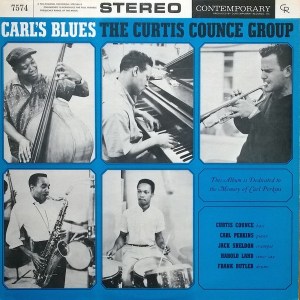
- A superb sounding copy on the real Contemporary label, boasting outstanding Double Plus (A++) sound from start to finish – fairly quiet vinyl throughout
- This vintage pressing has the studio space, presence, driving energy, and midrange magic that’s almost always missing from whatever 180g reissue (at 33 or 45, don’t fall for that BS) has been made from the 59 year old tapes
- “Although the Curtis Counce Quintet was not a commercial success, their four Contemporary albums were all timeless in their own way, undated examples of high-quality hard bop from the late ’50s. Excellent music that still sounds fresh four decades later.”
This vintage Contemporary pressing has the kind of Tubey Magical Midrange that modern records can barely BEGIN to reproduce. Folks, that sound is gone and it sure isn’t showing signs of coming back. If you love hearing INTO a recording, actually being able to “see” the performers, and feeling as if you are sitting in the studio with the band, this is the record for you. It’s what vintage all analog recordings are known for — this sound.
If you exclusively play modern repressings of vintage recordings, I can say without fear of contradiction that you have never heard this kind of sound on vinyl. Old records have it — not often, and certainly not always — but maybe one out of a hundred new records do, and those are some pretty long odds.
What amazing sides such as these have to offer is not hard to hear:
- The biggest, most immediate staging in the largest acoustic space
- The most Tubey Magic, without which you have almost nothing. CDs give you clean and clear. Only the best vintage vinyl pressings offer the kind of Tubey Magic that was on the tapes in 1960
- Tight, note-like, rich, full-bodied bass, with the correct amount of weight down low
- Natural tonality in the midrange — with all the instruments having the correct timbre
- Transparency and resolution, critical to hearing into the three-dimensional studio space
No doubt there’s more but we hope that should do for now. Playing the record is the only way to hear all of the qualities we discuss above, and playing the best pressings against a pile of other copies under rigorously controlled conditions is the only way to find a pressing that sounds as good as this one does.
What We Listen For on Carl’s Blues
- Energy for starters. What could be more important than the life of the music?
- Then: presence and immediacy. The instruments aren’t “back there” somewhere, lost in the mix. They’re front and center where any recording engineer worth his salt would put them.
- The Big Sound comes next — wall to wall, lots of depth, huge space, three-dimensionality, all that sort of thing.
- Then transient information — fast, clear, sharp attacks, not the smear and thickness so common to these LPs.
- Tight punchy bass — which ties in with good transient information, also the issue of frequency extension further down.
- Next: transparency — the quality that allows you to hear deep into the soundfield, showing you the space and air around all the instruments.
- Extend the top and bottom and voila, you have The Real Thing — an honest to goodness Hot Stamper.
TRACK LISTING
Side One
Pink Lady
I Can’t Get Started
Nica’s Dream
Side Two
Love Walked In
Larue
The Butler Did It
Carl’s Blues
AMG Review
Although the Curtis Counce Quintet was not a commercial success, their four Contemporary albums (which have been reissued on CD) were all timeless in their own way, undated examples of high-quality hard bop from the late ’50s. This set features the bassist-leader, either Jack Sheldon or Gerald Wilson on trumpet, tenor saxophonist Harold Land, pianist Carl Perkins and drummer Frank Butler interpreting both jazz standards (including “Love Walked In” and Clifford Brown’s “Larue”) and originals (such as the drummer’s “The Butler Did It”). Excellent music that still sounds fresh four decades later.